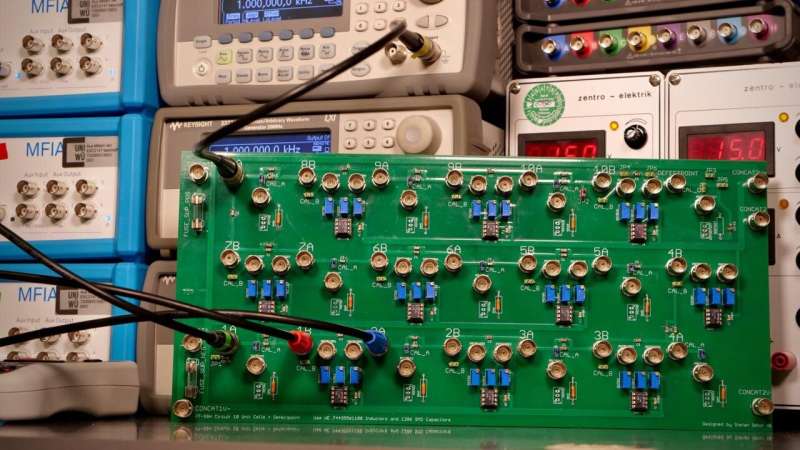A 'topolectric circuit' used to realize the topological states studied here. Credit: Lukas Ziegler
In a joint effort, ct.qmat scientists from Dresden, Rostock, and Würzburg have accomplished non-Hermitian topological states of matter in topolectric circuits. The latter acronym refers to topological and electrical, giving a name to the realization of synthetic topological matter in electric circuit networks. The main motif of topological matter is its role in hosting particularly stable and robust features immune to local perturbations, which might be a pivotal ingredient for future quantum technologies. The current ct.qmat results promise a knowledge transfer from electric circuits to alternative optical platforms, and have just been published in Physical Review Letters.
Topological defect tuning in non-Hermitian systems
At the center of the currently reported work is the circuit realization of parity-time (PT) symmetry, as it has been previously intensely studied in optics. The ct.qmat team have employed the PT symmetry to still make the open circuit system with gain and loss share a large amount of features with an isolated system. This is a core insight in order to design topological defect states in a compensatingly dissipative and accumulative setting. It is accomplished through non-Hermitian PT topolectric circuits.
Potential paradigm change in synthetic topological matter
"This research project has enabled us to create a joint team effort between all locations of the Cluster of Excellence ct.qmat towards topological matter. Topolectric circuits create an experimental and theoretical inspiration for new avenues of topological matter, and might have a particular bearing on future applications in photonics. The flexibility, cost-efficiency, and versatility of topolectric circuits is unprecedented, and might constitute a paradigm change in the field of synthetic topological matter," summarizes the Würzburg scientist and study director Ronny Thomale.
Next stop: applications
Having built a one-dimensional version of a PT symmetry topolectric circuit with a linear dimension of 30 unit cells, the next step towards technology envisioned by the research team is to take on PT symmetric circuits in two dimensions and as such about 1000 coupled circuit unit cells. Eventually, the insight gained through topolectric circuits may establish one milestone that could make light-controlled computers possible. They would be much faster and more energy-efficient than today's electron-controlled models.
People involved
Besides the cluster members based at Julius-Maximilians-Universität Würzburg (JMU) and the Leibnitz Institute for Solid State and Materials Research Dresden (IFW), the scientists around Professor Alexander Szameit from the University of Rostock are also involved in the publication. The Cluster of Excellence ct.qmat cooperates with Szameit's group in the field of topological photonics.
More information: Alexander Stegmaier et al, Topological Defect Engineering and PT Symmetry in Non-Hermitian Electrical Circuits, Physical Review Letters (2021). DOI: 10.1103/PhysRevLett.126.215302
Journal information: Physical Review Letters
Provided by University of Würzburg
























